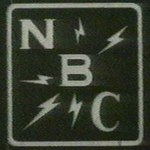Main article: Blue Network
NBC Red/Blue's secondary 1930s logo, commonly seen on the network's microphone flags.
At this time, most network programs were owned by the sponsors and produced by their advertising agencies. The networks did not control or "program" their own schedules as they do now (advertisers bought available time periods they wanted and chose the stations which would carry a particular program regardless of what other sponsors might broadcast in other time periods). Networks rented studio facilities to produce shows and sold air-time to sponsors. The only network produced programs were unsponsored programs used to fill unsold time periods (affiliated stations had the option to "break away" from the network to air a local program during these periods) but the network had the "option" to take back the time period if a network sponsor wanted the time period.[5]
Legend has it that the color designations originated from the color of the push-pins early engineers used to designate affiliates of WEAF (red pins) and WJZ (blue pins), or from the use of double-ended red and blue colored pencils. A similar two-part/two-color strategy appeared in the recording industry, dividing the market between classical and popular offerings.
On April 5, 1927 NBC reached the West Coast with the launching of the NBC Orange Network, which rebroadcast Red Network programming to the Pacific states and had as its flagship station KGO in San Francisco. NBC Red then extended its reach into the midwest by acquiring two 50,000 watt clear-channel signals, Cleveland station WTAM on October 16, 1930 and Chicago station WMAQ (coincidentally, a CBS Radio Network charter affiliate) by 1931. On October 18, 1931, Blue Network programming was introduced along the NBC Gold Network, which broadcast from San Francisco's KPO. In 1936 the Orange Network name was dropped and affiliate stations became part of the Red Network. The Gold Network adopted the Blue Network name.
In a major move in 1931, RCA signed crucial leases with the new Rockefeller Center management that resulted in it becoming the lead tenant of what was to become in 1933 its corporate headquarters, the RCA Building, at 30 Rockefeller Plaza. Under the terms of the lease arrangement, this included studios for NBC and theaters for the RCA-owned RKO Pictures. The deal was arranged through the Center's founder and financier, John D. Rockefeller, Jr., with the chairman of GE, Owen D. Young, and the president of RCA, David Sarnoff.[6]
In 1939 the FCC ordered RCA to divest itself of one of the two networks. RCA fought the divestiture order, but divided NBC into two companies in 1940 in case an appeal was lost. The Blue network became the "NBC Blue Network, Inc." (now known as ABC) and the NBC Red became "NBC Red Network, Inc." Effective January 10, 1942, the two networks had their operations formally divorced, and the Blue Network was referred to on the air as eith

No comments:
Post a Comment